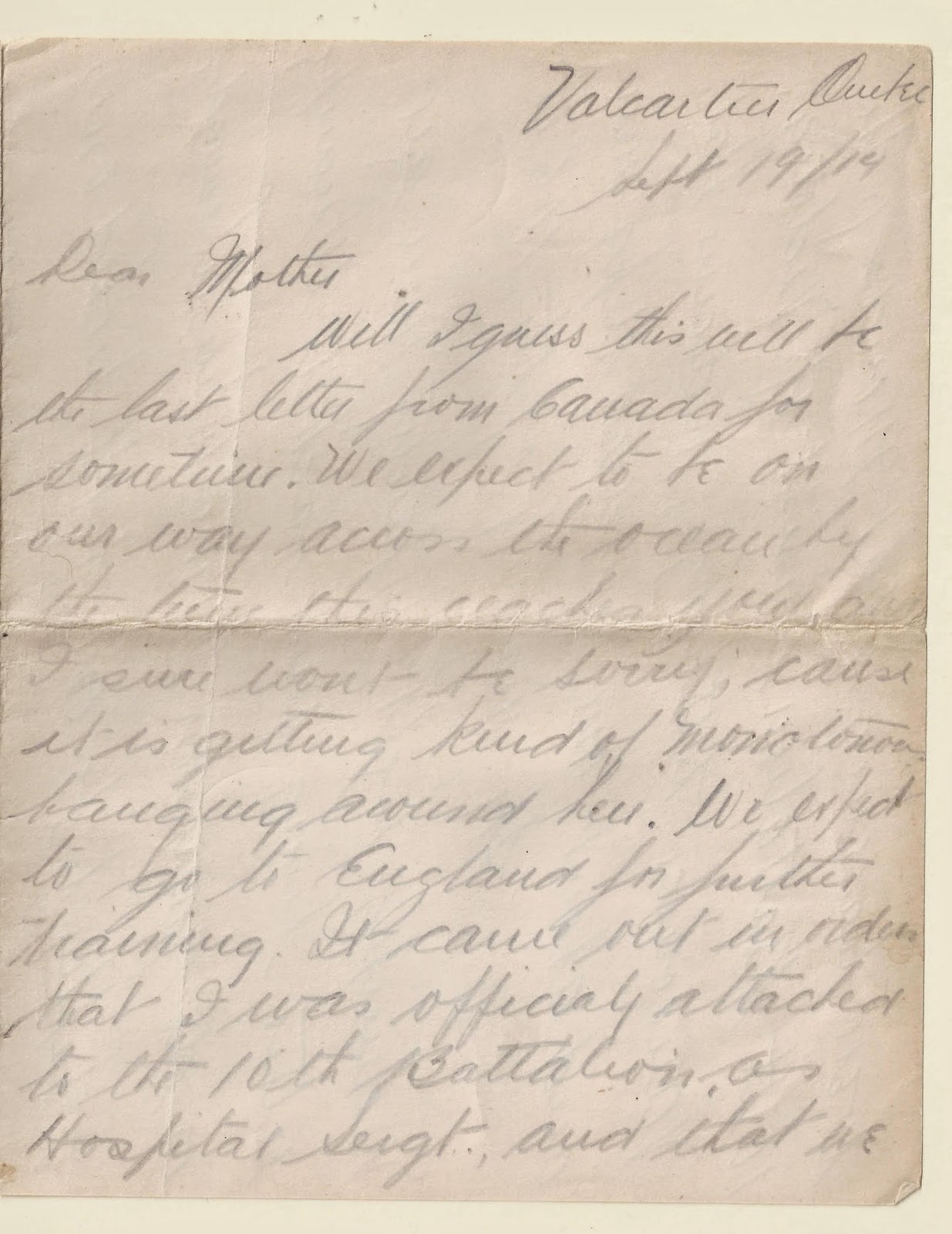to his folks in Viceroy Saskatchewan
Valcartier Camp
Sept 19th 1914
Dear Mother
Well I guess this will
be the last letter from Canada for sometime.
We expect to be on our way across the ocean by the time this reaches you
and I sure won’t be sorry cause it is getting kind of monotonous hanging around
here. It came out in order that I was
officially attached to the 10th Battalion as Hospital Sergeant and
that we were leaving about Monday. The
10th Battalion consist of Victoria, Vancouver, Lethbridge, Medicine
Hat and about one hundred Winnipeg men.
The majority of the 106th
Winnipeg Light Infantry men are either being sent back to Winnipeg or do
garrison somewhere in Canada. I happen
to one of the picked ones for the ¨10th
Battalion overseas contingent. Both the
doctor and I.
The nights here are very cold, but during the days it is fine
weather. They were selling views of
Valcartier camp and if I can locate any I will send you some.
Is Viceroy a very nice
town and are there any young people there and have you a drug store. If I make any money while I am away I am
going to take a store in one of those Sask. towns for a couple of years. Just got threw with the sick bunch a few
minutes ago and had to do it all my self as the doctor was up at Headquarters. Took about half of a mans toes off that had
been run over by a Calvary gun, don’t know if I can keep it from poisoning or
not. Poor fellow he fainted twice but I
had a man on his knees and another on his chest so it did not take long.
This is sure a great experience you don’t
stop to pity on a mans feeling here. If
a thing has got to be done, you do it if he dies next minute. The outfit I am with has had three
deaths. But as soon as they are carried
off a person thinks no more about them.
The doctor will be back in a
few minutes and I am going to get his horse and ride up to headquarters to see
if I get those Views. Well Mother I will
write you from the other side.
Remembrance to Pa and V-V, all kinds of luck and prosperity. Hope you and Pa will continue to like Viceroy
and that this finds you in good health and spirit.
Good bye and Good Luck
Chas.
_____________________________
Footnotes
Departure for Europe
The transportation of the army to the port of Quebec began on the wet night of 23/24 September 1914. The weather that night was so bad that the infantry were not expected to make the journey on foot and were brought from Valcartier camp in a long succession of trains. However, columns of field artillery and transport wagons and vehicles crawled the sixteen miles down the valley from Valcartier to Quebec in the rain and the mud. Arriving at daybreak the men were drenched, but morale was high because at last they were off to do the job for which they had volunteered. The whole embarkation of horses, men, guns and wagons was completed in less than three days.
The transportation of the army to the port of Quebec began on the wet night of 23/24 September 1914. The weather that night was so bad that the infantry were not expected to make the journey on foot and were brought from Valcartier camp in a long succession of trains. However, columns of field artillery and transport wagons and vehicles crawled the sixteen miles down the valley from Valcartier to Quebec in the rain and the mud. Arriving at daybreak the men were drenched, but morale was high because at last they were off to do the job for which they had volunteered. The whole embarkation of horses, men, guns and wagons was completed in less than three days.
Atlantic Crossing
The fleet of 33 Atlantic liners assembled in Gaspé Basin off the coast of Quebec province for a rendezvous with their Royal Navy warship escorts. On 3 October the transport ships steamed ahead out of Gaspé Bay in three lines led by Royal Navy warships: His Majesty's Ships were Charybdis, Diana, and Eclipse, with the Glory and Suffolk on the flanks, and the Talbot in the rear. Later, the Suffolk's place was taken by the battle-cruiser, Queen Mary.
Making its way up the St. Lawrence seaway the convoy passed through the gateway of Canada, the Gulf of St. Lawrence. As it passed the Avalon Peninsula of Newfoundland the sealing-ship SS Florizel, with the Newfoundland Regiment aboard, joined the fleet.
As the army set sail for Europe it was the first time that such a large contingent of troops had ever crossed the Atlantic.
Source History of the First Canadian Division






No comments:
Post a Comment